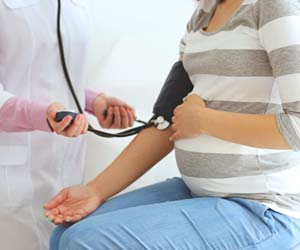Storing a greater proportion of body fat in the legs (pear-shaped) was linked to a significantly decreased risk of cardiovascular disease (CVD) in these women.

‘The highest risk of CVD occurred in women who had the highest percentage of fat around their middle and the lowest percentage of leg fat - they had a more than three-fold increased risk compared to women at the opposite extreme with the least body fat and the most leg fat.’





This is the first study to look at where fat is stored in the body and its association with risk of CVD in postmenopausal women with normal BMI (18.5 to less than 25 kg/m2). It involved 2,683 women who were part of the Women's Health Initiative in the USA, which recruited nearly 162,000 postmenopausal women between 1993 and 1998 and followed them until February 2017. They did not have CVD at the time of joining the study but, during a median (average) of nearly 18 years of follow-up, 291 CVD cases occurred. The researchers, led by Dr Qibin Qi, an associate professor at the Albert Einstein College of Medicine, New York (USA), found that women in the top 25% of those who stored most fat round their middle or trunk (apple-shaped) had nearly double the risk of heart problems and stroke when compared to the 25% of women with the least fat stored around their middle. In contrast, the top 25% of women with the greatest proportion of fat stored in their legs had a 40% lower risk of CVD compared with women who stored the least fat in their legs.
Dr Qi said: "Our findings suggest that postmenopausal women, despite having normal weight, could have varying risk of cardiovascular disease because of different fat distributions around either their middle or their legs. In addition to overall body weight control, people may also need to pay attention to their regional body fat, even those who have a healthy body weight and normal BMI.
"However, it is important to note that participants of our study were postmenopausal women who had relatively higher fat mass in both their trunk and leg regions. Whether the pattern of the associations could be generalisable to younger women and to men who had relatively lower regional body fat remains unknown."
The researchers calculated that, among 1000 women who kept their leg fat constant but reduced the proportion of trunk fat from more than 37% to less than 27%, approximately six CVD cases could be avoided each year, corresponding to 111 cases avoided over the 18 years of the study. Similarly, among 1000 women who kept their trunk fat constant but increased their leg fat from less than 42% to more than 49%, approximately three CVD cases could be avoided each year and 60 cases would have been avoided over the 18-year period.
Advertisement
"Our findings highlight the need for using anthropometric measures that better reflect regional fat distribution to identify increased risk of cardiovascular disease. These are important research directions for future population studies."
Advertisement
When women reach the menopause, they can undergo changes in their body shape and metabolism; more fat may be stored around the organs in the body rather than underneath the skin. In addition, the distribution of body fat is determined by both genetics and exposure to environmental factors, such as diet and exercise.
"While there have been some large studies of genetic determinants of upper- and lower-body fat, fewer large studies have focused on lifestyles factors, though modifiable factors such as physical activity and dietary intakes are thought to play key roles in determining an individual's fat distribution," said Dr Qi. "In the next step, our group will focus on the long-term impacts of dietary habits on fat distribution among these postmenopausal women, and evaluate whether and how dietary habits may affect multiple health risks, such as risk of cancer, cardiovascular disease and premature death, through the impacts on the distribution of body fat."
It is known already that fat stored around the organs in the abdomen increases the risk of metabolic problems, such as worse control of blood sugar levels, raised levels of insulin, inflammation and higher cholesterol levels, that can lead to cardiovascular disease. The mechanisms underlying the reason why increased leg fat may be protective are less well understood, but may be because fat stored in the legs is not causing problems elsewhere in the body.
In an accompanying editorial [2], Professor Matthias Blüher and Professor Ulrich Laufs, from the University of Leipzig, Germany, write: "The study may inspire novel concepts of how a dysbalance between 'atherogenic' and 'anti-atherogenic' fat depots may indirectly contribute to vascular damage. Importantly, the study identifies a. positive effect of leg fat on ASCVD [atherosclerotic cardiovascular disease] risk."
Source-Eurekalert










